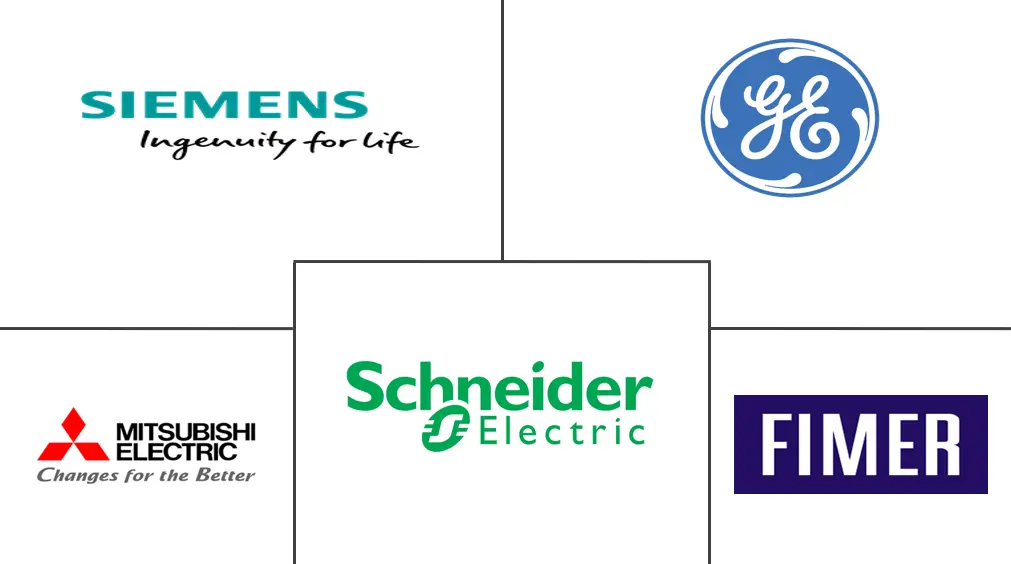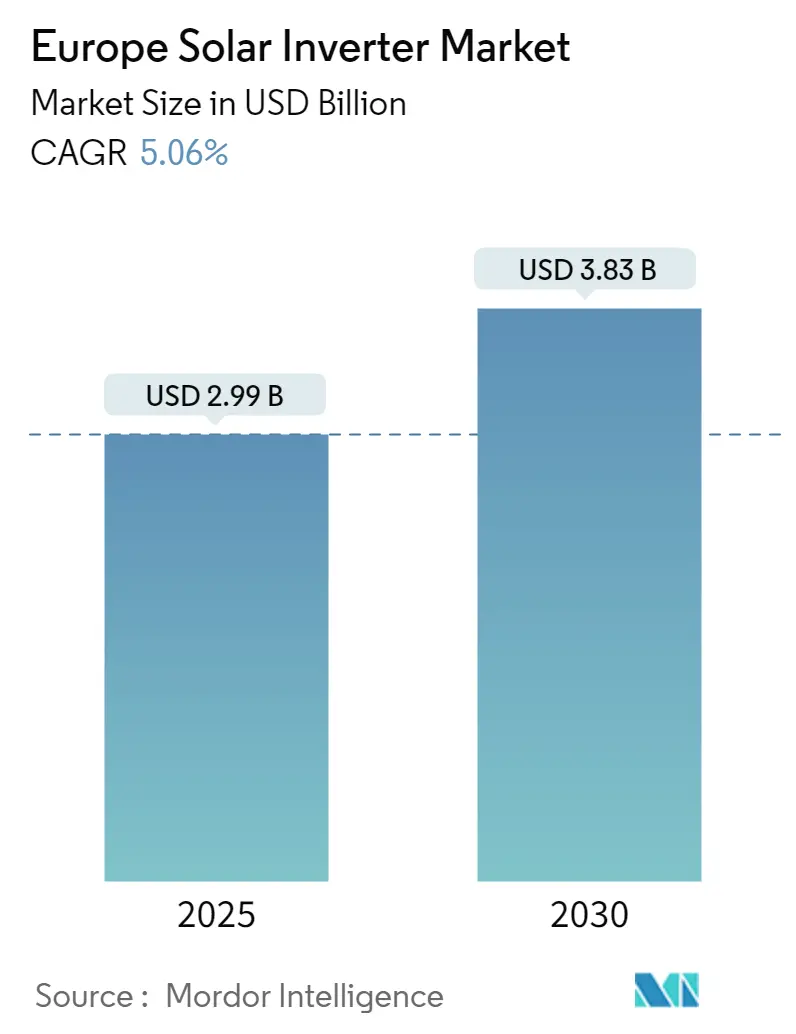
Europe Solar Inverter Market Analysis by Mordor Intelligence
The Europe Solar Inverter Market size is estimated at USD 2.99 billion in 2025, and is expected to reach USD 3.83 billion by 2030, at a CAGR of 5.06% during the forecast period (2025-2030).
- Over the medium period, factors such as supportive government initiatives and investment in electrification using solar energy are expected to support the European solar inverters market.
- On the other hand, the lack of general awareness, infrastructure development costs, and recent subsidy cuts on solar panels by governments in the European region are expected to hinder the growth of the market studied during the forecast period.
- Nevertheless, inverter manufacturers strive for innovation and adoption of the latest technologies powered by solar energy. This factor is expected to create immense opportunities for the European solar inverters market in the near future.
- Germany is expected to be the fastest and largest growing market during the forecast period, with the majority of the demand coming from residential and utility-scale projects.
Europe Solar Inverter Market Trends and Insights
Central Inverters Expected to Dominate the Market
- A central inverter is a large grid feeder. It is often used in solar photovoltaic systems with rated outputs over 100 kWp. Typically, floor or ground-mounted inverters convert DC power collected from a solar array into AC power for grid connection. These devices range in capacity from around 50kW to 1MW and can be used indoors or outdoors.
- Generally, a central inverter consists of one DC-AC conversion stage. Some inverters also have a DC-DC boost stage to increase their MPP (Maximum Power Point) voltage range. Low-frequency transformers are sometimes used to boost the AC voltage and provide isolation at the output. However, this reduces efficiency and increases the inverter's size, weight, and cost.
- A central inverter typically has a maximum input voltage of 1,000V. However, some newer central inverters already come with 1,500V input voltage. These inverters allow PV arrays with a maximum voltage of 1,500V, requiring fewer BOS (balance of system) components.
- Central inverters can be monolithic (using a single power train and multi-MPPT tracker) or modular (using multiple power trains). Modular inverters are more complex but can maintain reduced power output if one or more modules fail and can use either a multi-MPPT or a master-slave control approach. The multi-MPPT system uses a separate converter and MPPT for each floating sub-array, increasing the overall energy harvest under partial shading conditions. In the master-slave approach, the controller module is always on. It commands the slave modules (the slaves) to switch on when more power is available from the array, which maximizes inverter efficiency in low-insolation environments.
- As central inverters are used for utility-scale applications, they should produce the same voltage and frequency as that of the electric grid where they are used. As there are a lot of different electric grid standards worldwide, manufacturers are allowed to customize these parameters to match the specific requirements in terms of the number of phases; most central inverters manufactured are three-phase inverters.
- According to Terna, as of November 2023, larger solar PV installations with a capacity above 200 kilowatts amounted to around 20,000 units. This trend is expected to increase during the forecast period, driving the central inverters market in Italy.
- In July 2022, Sungrow, a global inverter and energy storage system solution supplier, signed a contract to supply PV inverters to a 154 MW Ratesti PV plant in Romania with the project’s EPC system provider, INTEC Energy Solutions. It is a significant project of this type in Romania, promoting the energy transition and energy independence in Southeast Europe. The facility is located in southern Romania's Arges County. The project is expected to generate 124 GWh of clean energy annually and power 100,000 households, representing a reduction of 160,000 tons of carbon emissions.
- Therefore, owing to the above points, the central inverters segment is expected to dominate the market growth during the forecast period.
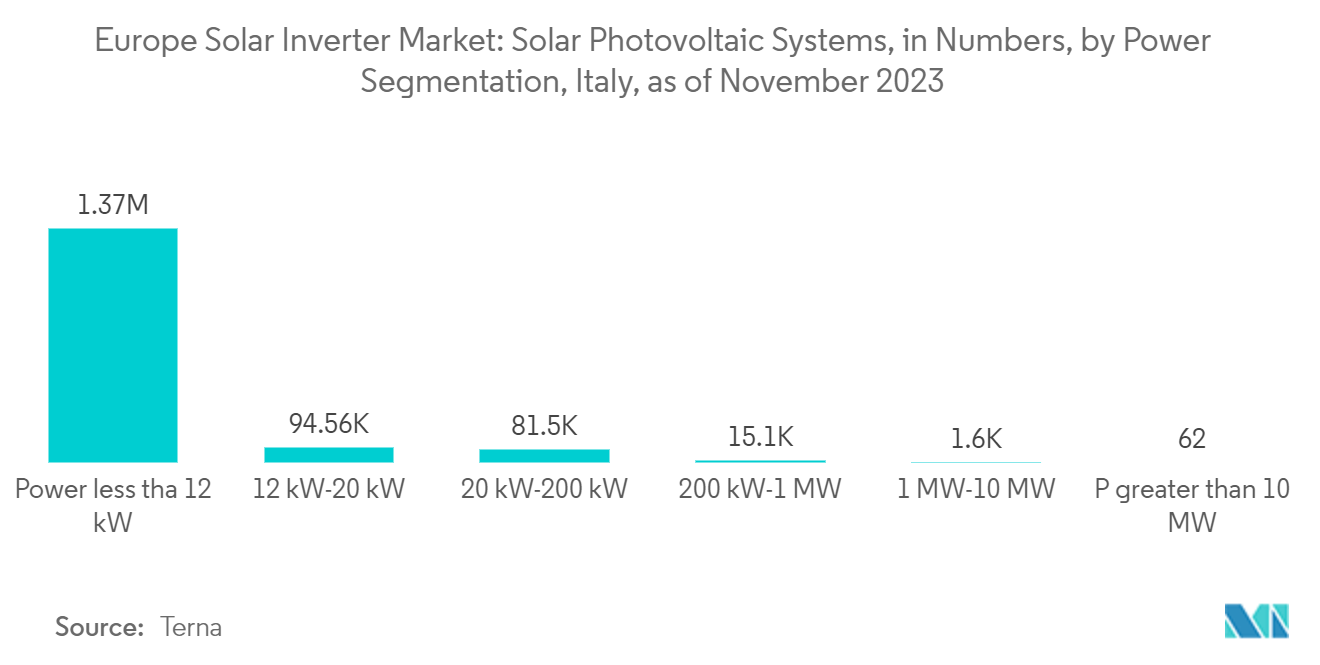
Germany Expected to Dominate the Market
- Germany is Europe's largest solar photovoltaic market regarding installed capacity, which justifies it as one of the front runners in energy and climate security globally. The country has witnessed significant developments in the solar PV market. It is expected to continue to do so due to a combination of self-consumption with attractive feed-in premiums, especially for medium- to large-scale commercial systems that range from 40 kW to 750 kW.
- The FiT scheme has made it profitable for homeowners and small businesses to opt for solar power. This has been a major driver for the country’s solar inverters market.
- The cumulative solar photovoltaic installed capacity in Germany has witnessed significant growth. According to Solarpower Europe, in 2023, Germany was expected to lead the EU solar market in both annual and total installations, with 14.1 GW and 82.1 GW, respectively.
- Under the Renewable Energy Act of 2021, solar PV installations on rooftops of over 750 kilowatt-peak (kWp) to participate in tenders, while all systems between 300 and 750 kW are offered the choice of either participating in a tender or taking advantage of fixed feed-in tariffs and consume part of their electricity themselves. The latter will only receive feed-in payments for 50% of their electricity.
- In May 2022, Germany's Federal Network Agency, the Bundesnetzagentur, concluded the third rooftop PV tender with an average price of EUR 0.0853/kWh. The agency reviewed 171 bids with a total capacity of 212 MW and selected 163 projects totaling 204 MW. The final prices ranged between EUR 0.07 /kWh and EUR 0.0891/kWh. The second rooftop PV tender was concluded in January 2022, and the agency reviewed 209 bids with a total capacity of 233 MW, of which 136 projects were selected, totaling 154 MW. The final prices ranged between EUR 0.0570/kWh and EUR 0.0828/kWh. The final average price was EUR 0.0743.
- In April 2022, Germany's Federal Network Agency announced that it had selected 201 proposals with a combined output of 1.084 GW under the solar auction, up from 510.34 MW in July 2021. The bids in the round ranged from EUR 0.040 to EUR 0.055 per kWh. The volume-weighted average price stood at EUR 0.0519 (USD 0.057) per kWh, up from EUR 0.050 per kWh in the previous round.
- Instead of a centralized generation of utility-scale thermal power, localized renewable generation is the only way to decarbonize the power generation sector. Distributed grid offers an attractive way to integrate increasing volumes of renewable energy into the energy mix.
- With the cost of solar PV modules and energy storage systems, such as lithium-ion batteries, reduced and the added benefit of reduced ancillary cost at the time of peak demand, the solar PV market is expected to grow during the forecast period, which, in turn, is expected to drive the solar inverters market in the country.
- Thus, owing to the above points, Germany is expected to dominate the market in the forecast period.
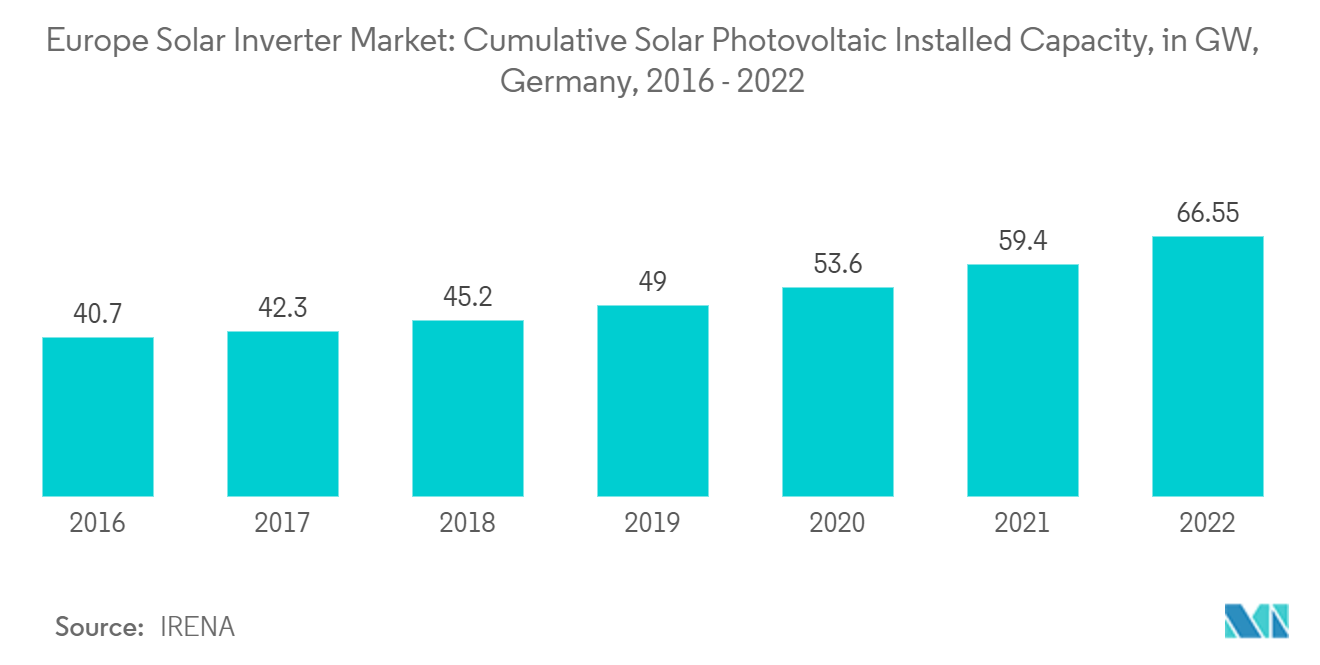
Competitive Landscape
The European solar inverters market is highly fragmented. The key players (in no particular order) in the market include FIMER SpA, Schneider Electric SE, Siemens AG, Mitsubishi Electric Corporation, and General Electric Company, among others.
Europe Solar Inverter Industry Leaders
Schneider Electric SE
Siemens AG
FIMER SpA
Mitsubishi Electric Corporation
General Electric Company
- *Disclaimer: Major Players sorted in no particular order
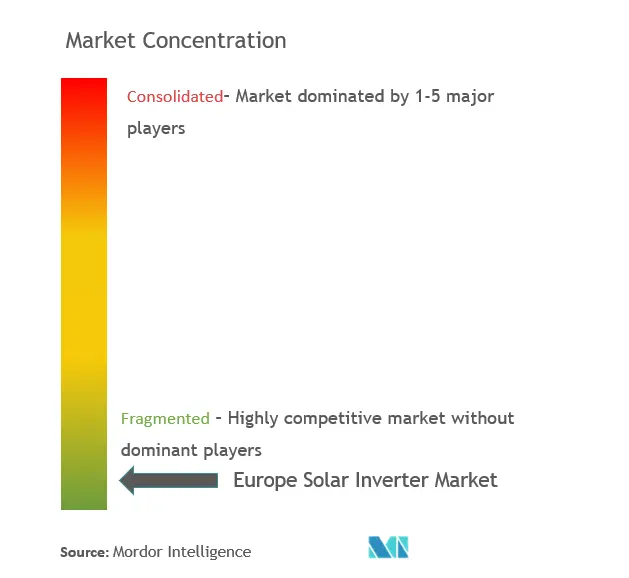
Recent Industry Developments
- June 2022: SMA Solar Technology AG announced plans to build a solar inverter manufacturing facility in Niestetal, Germany. The new gigawatt factory is a part of the company’s target to double the production capacity from 21GW (present) to 40GW by 2024. The construction was expected to begin by the end of 2022.
- April 2022: SMA Solar Technology AG launched four new models of solar inverters for commercial and residential PV systems with power outputs of up to 135kW. The new Sunny Tripower-X models with ratings of 12kW, 15kW, 20kW, and 25kW feature an exclusive system manager, three independent MPP trackers, and six-string inputs. The inverters provide grid-compliant power control of entire systems and over-dimensioning PV systems by up to 150%.
Europe Solar Inverter Market Report Scope
A solar PV inverter is a power inverter that converts electricity in direct current (DC) output from a photovoltaic (PV) solar panel into alternating current (AC) at utility frequency. This can be fed into use for commercial electrical grids or used by a local off-grid electrical network, such as micro-grids or nano-grids. The inverter system is critical for the balance of system components in a photovoltaic system, allowing the use of ordinary AC-powered equipment. Solar power inverters have special functions adapted for use with photovoltaic arrays, including maximum power point tracking and anti-islanding protection.
The European solar inverters market is segmented by inverter type, application, and geography. By inverter type, the market is segmented into central inverters, string inverters, and micro-inverters. By application, the market is segmented into residential, commercial and industrial, and utility-scale. The report also covers the market size and forecasts for the European solar inverter market across major countries in the region. The report offers the market size in value terms in USD for all the abovementioned segments.
| Central Inverters |
| String Inverters |
| Micro Inverters |
| Residential |
| Commercial and Industrial |
| Utility-scale |
| Germany |
| United Kingdom |
| France |
| Spain |
| Italy |
| Nordic Countries |
| Turkey |
| Russia |
| Rest of Europe |
| Inverter Type | Central Inverters |
| String Inverters | |
| Micro Inverters | |
| Application | Residential |
| Commercial and Industrial | |
| Utility-scale | |
| Geography | Germany |
| United Kingdom | |
| France | |
| Spain | |
| Italy | |
| Nordic Countries | |
| Turkey | |
| Russia | |
| Rest of Europe |
Key Questions Answered in the Report
How big is the Europe Solar Inverter Market?
The Europe Solar Inverter Market size is expected to reach USD 2.99 billion in 2025 and grow at a CAGR of 5.06% to reach USD 3.83 billion by 2030.
What is the current Europe Solar Inverter Market size?
In 2025, the Europe Solar Inverter Market size is expected to reach USD 2.99 billion.
Who are the key players in Europe Solar Inverter Market?
Schneider Electric SE, Siemens AG, FIMER SpA, Mitsubishi Electric Corporation and General Electric Company are the major companies operating in the Europe Solar Inverter Market.
What years does this Europe Solar Inverter Market cover, and what was the market size in 2024?
In 2024, the Europe Solar Inverter Market size was estimated at USD 2.84 billion. The report covers the Europe Solar Inverter Market historical market size for years: 2019, 2020, 2021, 2022, 2023 and 2024. The report also forecasts the Europe Solar Inverter Market size for years: 2025, 2026, 2027, 2028, 2029 and 2030.
Page last updated on:
Europe Solar Inverter Market Report
Statistics for the 2025 Europe Solar Inverter market share, size and revenue growth rate, created by Mordor Intelligence™ Industry Reports. Europe Solar Inverter analysis includes a market forecast outlook for 2025 to 2030 and historical overview. Get a sample of this industry analysis as a free report PDF download.
